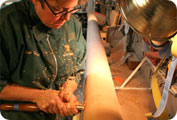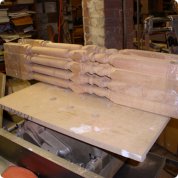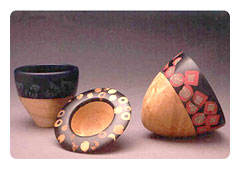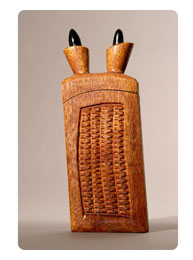
Over the years, Beth Ireland has made quite a name for herself in the field of woodworking as a cabinetmaker, furniture maker, architectural turner, spiral stair maven, lathe artist and woodworking instructor and lecturer. How does she do it all? “I’m a workaholic,” she admits. “I often work 50 or 60 hours a week. My life is about woodworking and making things for people.”
Though she has clearly arrived, getting there was not that easy. From the very beginning, there was some serious resistance to a woman in the shop. “In my high school, girls were not allowed to take shop or drafting,” Beth recounted. “I went to Buffalo State College to become an art teacher, and in the process managed to take a lot of woodworking courses. After college, I moved to Boston and became a book illustrator, an off-and-on sort of job, and worked as a cook between jobs. I’ve always wanted to own my own home, so I decided to learn carpentry in 1979.
“I must have made 50 calls to get a job, but everyone laughed at me saying things like ‘we don’t hire girls.’ One day in 1980 I lucked out. I called a man whose ad was in the paper, asked, ‘Are you hiring?’ and he said ‘Can you be here at three? I just fired someone.’ I quit cooking and illustrating and hired on full-time as an apprentice carpenter.
“I already knew how to use tools, so I moved up quickly. I was the sort who was willing to stay late and help out. My boss was the sort who took on jobs over his head. At times he’d take me on estimates and I would ask how we were going to do that. Often he didn’t know, but he believed you could learn whatever you needed to know, and I was interested in learning. He would buy whatever books I needed and pay for whatever courses I needed to take. I read every book I could get my hands on and learned fast.
“By 1982, I had become his in-house specialist doing all his built-in kitchens and cabinets. Basically all that meant was that I could make boxes and put them together in interesting ways.” That sounds glib, but in truth her approach to such work actually goes vastly further. “When you go into people’s homes,” she explains, “their environment is a very delicate place to be. You must really listen to them, hear how they feel about their space, and look at what they already have. If I do a kitchen, I will first have dinner with the client and watch them cook before I design for them. I try to make not what I want but what I hope will make them happy.
“I stayed at that job until 1984 when I opened my own shop. My first job was for a guy connected to the Filipino consulate. I built 500 plywood boxes with screw-down lids so that he could take his 45 rpm record collection back home to the Philippines.
“By 1986, things were really booming in Boston, and little by little my company expanded until I had hired four people. We did one complex job building a spiral staircase in a tower, and before long we were known for spiral staircases, but we did pretty much everything, including freestanding furniture and built-in pieces. As the economy soured in 1989, I began to lose my employees through attrition and did not hire them back. There was another woodworker in my building, and I would partner with him when one of us had a large job.”
Then came a turning point that was to change the course of her career. “In 1992, I hurt my back and closed my shop. It took a year and a half to recover, during which time I set up a small lathe in my basement and turned small objects to sell at galleries. I also joined the local AAW[American Assocation of Woodturners] chapter, a woodturning guild. Prior to this, I had always subbed out all my turning, but I loved it so much that I went sort of crazy turning bowls and architectural objects.
“Architectural wood turning kept me going through the recession, and I am now quite well known for that sort of work. I often have to do many multiples of identical architectural spindles. That does not bother me. For one thing, it is meditative, but perhaps more importantly, it gives you the skill so that you can do whatever you have to do without thinking about how to make it, which is very handy when turning art pieces.”
Apparently that works, because Beth is well known for her skilled art turning. “If I were to describe myself, I would say by day I am a traditional craftsperson, and by night I am an artist. I am very practical about meeting deadlines, making profits, and getting things done, but at night I build for myself.”
Some of her art pieces are rather unusual, like her wood and resin bowls. “I started casting objects in resin on blanks, then turning the whole into a bowl. Though they sell in galleries, I never taught that technique to anyone else. It takes too long for a short class and uses toxic materials.” Sadly, there was a price to pay for that. “Unfortunately, I have become sensitized to the resin and can’t do it indoors anymore,” she explained. “I also must now send all my finishing work out to others and have lost much of my sense of smell.”
As she learned, she shared her knowledge with others. “In 1984, I started teaching woodworking, mostly for adult education classes and woodworking stores. Over the years I’ve taught woodworking, cabinetmaking, turning and sculpture. In the past few years, I have started teaching at some of the more elite woodworking venues like Arrowmont, Anderson Ranch, and The Center for Furniture Craftsmanship. It is so inspirational to go there because of the level of art and craft that is taking place among the students. In 1999, I was asked to be the department head of the woodworking program at Wooster Center for Crafts. I did it for two years and really liked it, but I did not like being in charge of it all. That made it so that I could not do any of my own personal work.
“I now teach an intro to wood course for sculpture students at Mass College of Art. They learn hand and stationary tools, joinery as it relates to sculpture and so on. These students approach it from the point of view not of ‘what can I make’ but rather ‘what do I want to make.’ Instead of copying other woodworkers, they come with a drawing and a vision, and the nuts and bolts of making it is secondary to them. That is so refreshing, and is much closer to my natural bent as an artist. I teach people how to open their minds and be creative, and frequently volunteer to teach creative process to high school kids.” She also produced a DVD which she sells on her web site, and describes it as being about punching up your creativity.
“If I had it all to do over again there are two things I would have done differently,” she admits. “First, I wish I could have gone to school just to take a course on hand tools. I had to pick it up as I went along, but it would have been nice to start there. Second, I would buy only really good pieces of equipment and hand tools. That totally changes your life and the act of woodworking.”
As for her substantial productivity, Beth notes rather philosophically that “you are born at one end of the line and die at the other, and there’s a lot to do in between. Don’t waste time. Get to it, have fun, and don’t take yourself too seriously.”













